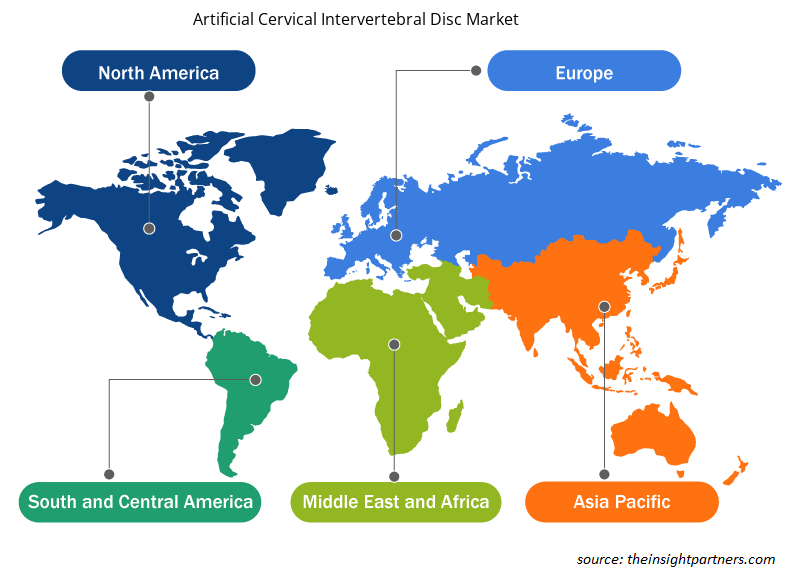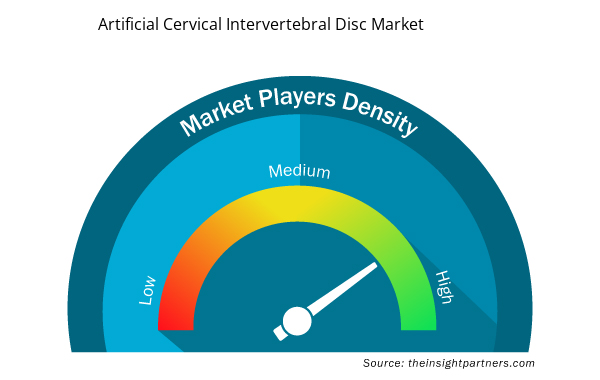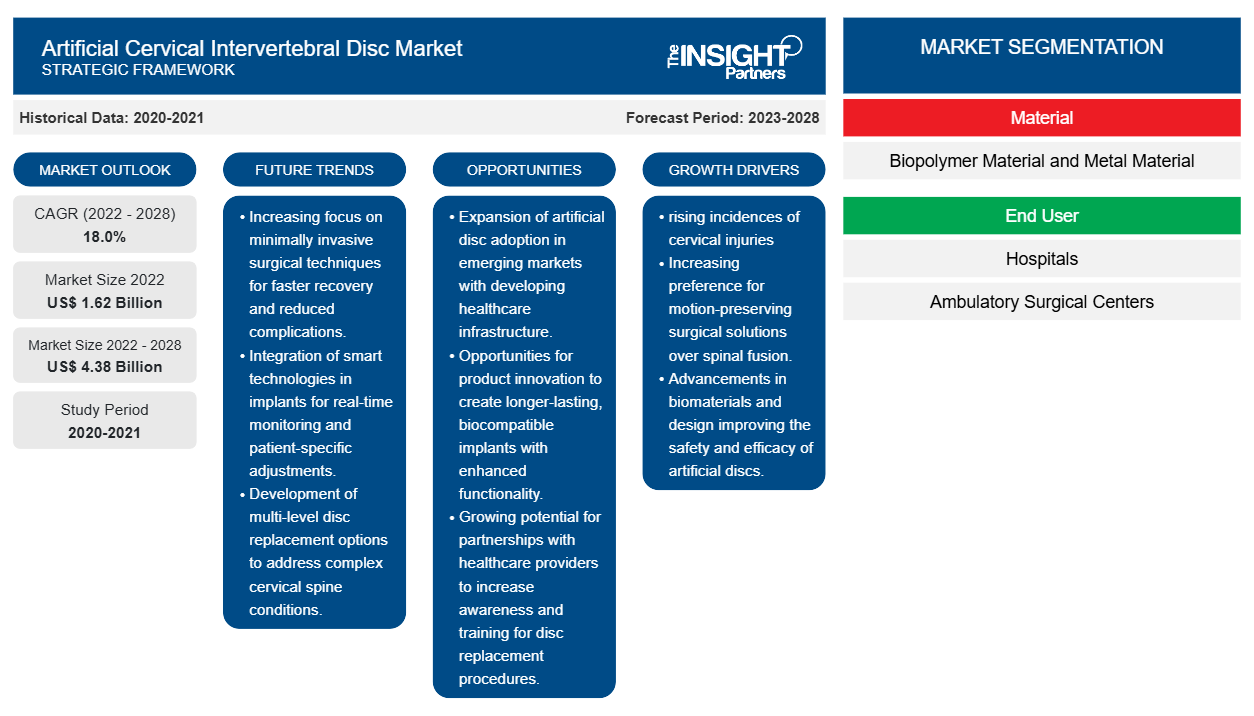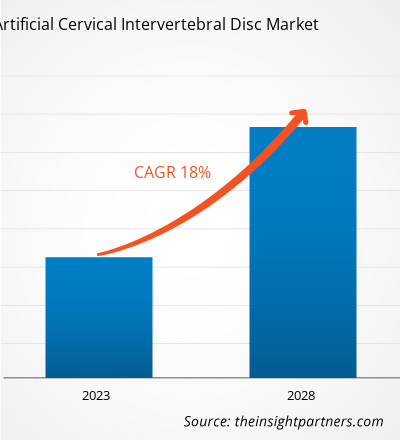[Informe de investigación] Se espera que el tamaño del mercado de discos intervertebrales cervicales artificiales crezca de US$ 1.621,66 millones en 2022 a US$ 4.375,29 millones en 2028; se estima que crecerá a una CAGR del 18,0% entre 2022 y 2028.
El crecimiento del mercado de discos intervertebrales cervicales artificiales se atribuye a la creciente prevalencia de lesiones cervicales. Los traumatismos son la principal causa de lesiones cervicales, incluidos accidentes de tráfico, traumatismos penetrantes o contundentes, caídas y lesiones deportivas o de buceo. Según el estudio "Estimación del número de lesiones de la columna cervical relacionadas con accidentes de tráfico en EE. UU.: un análisis y comparación de los datos nacionales de accidentes y hospitales", publicado en 2020, en EE. UU., se observan anualmente ~869 000 lesiones de la columna cervical relacionadas con accidentes de tráfico en los hospitales, de las cuales ~841 000 son lesiones por esguince/distensión (latigazo cervical), 2800 son lesiones de disco espinal, 23 500 son fracturas, 2800 son lesiones de la médula espinal y 1500 dislocaciones. Además, la mayoría de las lesiones deportivas son lesiones ortopédicas, que incluyen distensiones, esguinces, fracturas, ligamentos rotos, dolor e hinchazón; estas pueden ser agudas o crónicas. Según Stanford Children's Health, aproximadamente 30 millones de jóvenes y niños en los EE. UU. practican deportes anualmente, y cada año se informan más de 3,5 millones de lesiones relacionadas con el deporte. Una fractura cervical es el resultado de un traumatismo de alta energía, como una caída en gimnasia, hockey, fútbol o buceo. La incidencia de fracturas es alta en los atletas. Según Spinal Cord Injury Facts and Figures at a Glance, 2020, en los EE. UU., aproximadamente el 7,8 % del total de lesiones de la médula espinal (LME) se deben a los deportes. Según la Comisión de Seguridad de Productos para el Consumidor de EE. UU. (CPSC), en 2018, se trataron aproximadamente 23 720 fracturas de cuello en las salas de emergencia de los hospitales de EE. UU.; de estas, aproximadamente 3194 fracturas se debieron a los deportes. La incidencia de lesiones deportivas aumenta con el aumento de la participación en deportes y la participación activa en actividades de acondicionamiento físico debido al creciente enfoque en la vida saludable en todo el mundo. Además, según el Centro Nacional de Estadísticas de Lesiones de la Médula Espinal, el buceo es la quinta causa principal de lesión grave de la médula espinal cervical. Por lo tanto, la demanda de discos intervertebrales cervicales artificiales está aumentando debido a la creciente incidencia de lesiones cervicales.
El disco intervertebral cervical tiene la capacidad de absorber una enorme carga de compresión al tiempo que proporciona diferentes tipos de movimiento entre los huesos del cuello. Los actores del mercado han desarrollado varios discos intervertebrales cervicales artificiales que se utilizan para tratar problemas de disco cervical. El disco cervical artificial reemplaza la función de movimiento y amortiguación del disco cervical dañado.
Personalice este informe según sus necesidades
Obtendrá personalización en cualquier informe, sin cargo, incluidas partes de este informe o análisis a nivel de país, paquete de datos de Excel, así como también grandes ofertas y descuentos para empresas emergentes y universidades.
- Obtenga las principales tendencias clave del mercado de este informe.Esta muestra GRATUITA incluirá análisis de datos, desde tendencias del mercado hasta estimaciones y pronósticos.
Perspectivas del mercado
El aumento de la población geriátrica impulsa el mercado de los discos cervicales intervertebrales artificiales
El proceso de envejecimiento afecta la columna cervical, el cuello, los hombros, la parte superior de la espalda y los brazos. La espondilosis cervical es un término que se refiere al desgaste de los discos espinales del cuello relacionado con la edad. Es una enfermedad común y empeora con la edad. Según la Academia Estadounidense de Cirujanos Ortopédicos, aproximadamente el 85 % de las personas mayores de 60 años padecen espondilosis cervical. Con la edad, los discos vertebrales, que sirven como amortiguadores, se secan gradualmente y afectan la resistencia. Según la Hoja informativa: Envejecimiento en los Estados Unidos, se estima que el número de personas de 65 años o más llegará a aproximadamente 95 millones para 2060, frente a los 52 millones de 2018, y es probable que su proporción en la población total aumente hasta el 23 % desde el 16 %. Además, según el informe “Later Life in the UK 2019 - Age UK”, aproximadamente 12 millones (11.989.322) de personas tienen 65 años o más en el Reino Unido, de las cuales 5,4 millones tienen 75 años o más y 1,6 millones tienen 85 años. Además, Japón es otra nación en proceso de envejecimiento, con un 28,7% de su población con 65 años o más. La sociedad “superenvejecida” del país es la más antigua del mundo. Por lo tanto, es probable que el creciente envejecimiento de la población aumente la demanda de discos intervertebrales cervicales artificiales.
Perspectivas basadas en materiales
En función del material, el mercado de discos intervertebrales cervicales artificiales se ha dividido en material biopolimérico y material metálico. Es probable que el segmento de material biopolimérico tenga una mayor participación en el mercado en 2022, el crecimiento se atribuye principalmente a la biocompatibilidad y la facilidad de inserción que ofrecen los discos de material biopolimérico. Sin embargo, se prevé que el segmento de material metálico registre una mayor CAGR en el mercado durante 2022-2028.
Los actores del mercado de discos intervertebrales cervicales artificiales adoptan estrategias orgánicas, como el lanzamiento y la expansión de productos, para expandir su presencia y su cartera de productos a nivel mundial y satisfacer la creciente demanda. Los desarrollos de las empresas en el mercado global de discos intervertebrales cervicales artificiales se han caracterizado como desarrollos orgánicos e inorgánicos. Las estrategias de crecimiento orgánico adoptadas por los actores del mercado incluyen el lanzamiento y la expansión de productos. Las estrategias de crecimiento inorgánico observadas en el mercado de discos intervertebrales cervicales artificiales fueron asociaciones y colaboraciones. Estas estrategias de crecimiento han permitido a los actores del mercado expandir sus negocios y mejorar su presencia geográfica. Además, las estrategias de crecimiento como adquisiciones y asociaciones ayudaron a fortalecer la base de clientes de la empresa y aumentar su cartera de productos. Los desarrollos orgánicos representan el 80,95% de los desarrollos estratégicos totales en el mercado, mientras que las estrategias inorgánicas representan el 19,05% del crecimiento de las empresas.
El mercado de discos intervertebrales cervicales artificiales se ha segmentado de la siguiente manera:
El mercado de discos intervertebrales cervicales artificiales está segmentado en función del material y del usuario final. Según el material, el mercado se divide en biopolímeros y metales. El mercado global de discos intervertebrales cervicales artificiales, según el usuario final, está segmentado en hospitales, centros quirúrgicos ambulatorios y otros.
Perspectivas regionales del mercado de discos intervertebrales cervicales artificiales
Los analistas de Insight Partners explicaron en detalle las tendencias y los factores regionales que influyen en el mercado de discos intervertebrales cervicales artificiales durante el período de pronóstico. Esta sección también analiza los segmentos y la geografía del mercado de discos intervertebrales cervicales artificiales en América del Norte, Europa, Asia Pacífico, Oriente Medio y África, y América del Sur y Central.

- Obtenga datos regionales específicos para el mercado de discos intervertebrales cervicales artificiales
Alcance del informe de mercado de discos intervertebrales cervicales artificiales
| Atributo del informe | Detalles |
|---|---|
| Tamaño del mercado en 2022 | 1.620 millones de dólares estadounidenses |
| Tamaño del mercado en 2028 | US$ 4.38 mil millones |
| CAGR global (2022-2028) | 18,0% |
| Datos históricos | 2020-2021 |
| Período de pronóstico | 2023-2028 |
| Segmentos cubiertos | Por material
|
| Regiones y países cubiertos | América del norte
|
| Líderes del mercado y perfiles de empresas clave |
|
Densidad de actores del mercado de discos intervertebrales cervicales artificiales: comprensión de su impacto en la dinámica empresarial
El mercado de discos intervertebrales cervicales artificiales está creciendo rápidamente, impulsado por la creciente demanda de los usuarios finales debido a factores como la evolución de las preferencias de los consumidores, los avances tecnológicos y una mayor conciencia de los beneficios del producto. A medida que aumenta la demanda, las empresas amplían sus ofertas, innovan para satisfacer las necesidades de los consumidores y aprovechan las tendencias emergentes, lo que impulsa aún más el crecimiento del mercado.
La densidad de actores del mercado se refiere a la distribución de las empresas o firmas que operan dentro de un mercado o industria en particular. Indica cuántos competidores (actores del mercado) están presentes en un espacio de mercado determinado en relación con su tamaño o valor total de mercado.
Las principales empresas que operan en el mercado de discos intervertebrales cervicales artificiales son:
- Compañía: Zimmer Biomet Holdings, Inc.
- Compañía Médica Globus, Inc.
- Centinela Spine, LLC
- Soluciones de columna vertebral Synergy, Inc.
- Aditus Médico
Descargo de responsabilidad : Las empresas enumeradas anteriormente no están clasificadas en ningún orden particular.

- Obtenga una descripción general de los principales actores clave del mercado de discos intervertebrales cervicales artificiales
Perfiles de empresas
- Compañía: Zimmer Biomet Holdings, Inc.
- Compañía Médica Globus, Inc.
- Centinela Spine, LLC
- Soluciones de columna vertebral Synergy, Inc.
- B. Braun Melsugen AG
- Aditus Médico
- AxioMed LLC
- NuVasive, Inc.
- Medtronic
- Análisis histórico (2 años), año base, pronóstico (7 años) con CAGR
- Análisis PEST y FODA
- Tamaño del mercado Valor/volumen: global, regional, nacional
- Industria y panorama competitivo
- Conjunto de datos de Excel



Report Coverage
Revenue forecast, Company Analysis, Industry landscape, Growth factors, and Trends

Segment Covered
This text is related
to segments covered.

Regional Scope
North America, Europe, Asia Pacific, Middle East & Africa, South & Central America

Country Scope
This text is related
to country scope.
Preguntas frecuentes
An artificial cervical disc is a medical device designed to replace a natural disc in the neck through disc replacement surgery. It is inserted between two vertebrae in the neck and the surgery is generally performed in patients with a cervical disc herniation. The cervical artificial disc reduces the degradation of adjacent segments of the cervical spine and preserves normal neck motion.
The factors that are driving the growth of market are increasing incidences of cervical injuries and rising aging population. However, growing number of product approvals and developments is the major factor hindering the artificial cervical intervertebral disc market growth.
The artificial cervical intervertebral disc market majorly consists of the players, such as Zimmer Biomet Holdings, Inc.; Globus Medical, Inc.; Centinel Spine, LLC; Synergy Spine Solutions, Inc.; B. Braun Melsugen AG; Aditus Medical; AxioMed LLC; NuVasive, Inc.; Medtronic; and Orthofix Medical, Inc. among others.
The market is estimated to grow at a CAGR of 18.0% during the forecast period.
The artificial cervical intervertebral disc market is estimated to be valued at US$ 1,621.66 million in 2022.
The artificial cervical intervertebral disc market is expected to be valued at US$ 4,375.29 million in 2028.
The artificial cervical intervertebral disc market is analyzed on the basis of material and end user. Based on material, the market is segmented into biopolymer material and metal material. The biopolymer material segment held the largest share of the market. However, the metal material segment is anticipated to register the highest CAGR in the forecast period.
Asia Pacific is expected to be the fastest growing region in artificial cervical intervertebral disc market over the forecast period due to rising prevalence of the orthopedic diseases, increased in healthcare spending, and availability of advanced technology.
North America accounts for the major market share of artificial cervical intervertebral disc market in 2022 due to increasing aging population and the growing number of product approvals and developments.
Trends and growth analysis reports related to Life Sciences : READ MORE..
The List of Companies - Artificial Cervical Intervertebral Disc Market
- Zimmer Biomet Holdings, Inc.
- Globus Medical, Inc.
- Centinel Spine, LLC
- Synergy Spine Solutions, Inc.
- Aditus Medical
- AxioMed LLC
- NuVasive, Inc.
- Orthofix Medical, Inc.
- Medtronic
- B. Braun Melsugen AG.
The Insight Partners performs research in 4 major stages: Data Collection & Secondary Research, Primary Research, Data Analysis and Data Triangulation & Final Review.
- Data Collection and Secondary Research:
As a market research and consulting firm operating from a decade, we have published and advised several client across the globe. First step for any study will start with an assessment of currently available data and insights from existing reports. Further, historical and current market information is collected from Investor Presentations, Annual Reports, SEC Filings, etc., and other information related to company’s performance and market positioning are gathered from Paid Databases (Factiva, Hoovers, and Reuters) and various other publications available in public domain.
Several associations trade associates, technical forums, institutes, societies and organization are accessed to gain technical as well as market related insights through their publications such as research papers, blogs and press releases related to the studies are referred to get cues about the market. Further, white papers, journals, magazines, and other news articles published in last 3 years are scrutinized and analyzed to understand the current market trends.
- Primary Research:
The primarily interview analysis comprise of data obtained from industry participants interview and answers to survey questions gathered by in-house primary team.
For primary research, interviews are conducted with industry experts/CEOs/Marketing Managers/VPs/Subject Matter Experts from both demand and supply side to get a 360-degree view of the market. The primary team conducts several interviews based on the complexity of the markets to understand the various market trends and dynamics which makes research more credible and precise.
A typical research interview fulfils the following functions:
- Provides first-hand information on the market size, market trends, growth trends, competitive landscape, and outlook
- Validates and strengthens in-house secondary research findings
- Develops the analysis team’s expertise and market understanding
Primary research involves email interactions and telephone interviews for each market, category, segment, and sub-segment across geographies. The participants who typically take part in such a process include, but are not limited to:
- Industry participants: VPs, business development managers, market intelligence managers and national sales managers
- Outside experts: Valuation experts, research analysts and key opinion leaders specializing in the electronics and semiconductor industry.
Below is the breakup of our primary respondents by company, designation, and region:

Once we receive the confirmation from primary research sources or primary respondents, we finalize the base year market estimation and forecast the data as per the macroeconomic and microeconomic factors assessed during data collection.
- Data Analysis:
Once data is validated through both secondary as well as primary respondents, we finalize the market estimations by hypothesis formulation and factor analysis at regional and country level.
- Macro-Economic Factor Analysis:
We analyse macroeconomic indicators such the gross domestic product (GDP), increase in the demand for goods and services across industries, technological advancement, regional economic growth, governmental policies, the influence of COVID-19, PEST analysis, and other aspects. This analysis aids in setting benchmarks for various nations/regions and approximating market splits. Additionally, the general trend of the aforementioned components aid in determining the market's development possibilities.
- Country Level Data:
Various factors that are especially aligned to the country are taken into account to determine the market size for a certain area and country, including the presence of vendors, such as headquarters and offices, the country's GDP, demand patterns, and industry growth. To comprehend the market dynamics for the nation, a number of growth variables, inhibitors, application areas, and current market trends are researched. The aforementioned elements aid in determining the country's overall market's growth potential.
- Company Profile:
The “Table of Contents” is formulated by listing and analyzing more than 25 - 30 companies operating in the market ecosystem across geographies. However, we profile only 10 companies as a standard practice in our syndicate reports. These 10 companies comprise leading, emerging, and regional players. Nonetheless, our analysis is not restricted to the 10 listed companies, we also analyze other companies present in the market to develop a holistic view and understand the prevailing trends. The “Company Profiles” section in the report covers key facts, business description, products & services, financial information, SWOT analysis, and key developments. The financial information presented is extracted from the annual reports and official documents of the publicly listed companies. Upon collecting the information for the sections of respective companies, we verify them via various primary sources and then compile the data in respective company profiles. The company level information helps us in deriving the base number as well as in forecasting the market size.
- Developing Base Number:
Aggregation of sales statistics (2020-2022) and macro-economic factor, and other secondary and primary research insights are utilized to arrive at base number and related market shares for 2022. The data gaps are identified in this step and relevant market data is analyzed, collected from paid primary interviews or databases. On finalizing the base year market size, forecasts are developed on the basis of macro-economic, industry and market growth factors and company level analysis.
- Data Triangulation and Final Review:
The market findings and base year market size calculations are validated from supply as well as demand side. Demand side validations are based on macro-economic factor analysis and benchmarks for respective regions and countries. In case of supply side validations, revenues of major companies are estimated (in case not available) based on industry benchmark, approximate number of employees, product portfolio, and primary interviews revenues are gathered. Further revenue from target product/service segment is assessed to avoid overshooting of market statistics. In case of heavy deviations between supply and demand side values, all thes steps are repeated to achieve synchronization.
We follow an iterative model, wherein we share our research findings with Subject Matter Experts (SME’s) and Key Opinion Leaders (KOLs) until consensus view of the market is not formulated – this model negates any drastic deviation in the opinions of experts. Only validated and universally acceptable research findings are quoted in our reports.
We have important check points that we use to validate our research findings – which we call – data triangulation, where we validate the information, we generate from secondary sources with primary interviews and then we re-validate with our internal data bases and Subject matter experts. This comprehensive model enables us to deliver high quality, reliable data in shortest possible time.


 Obtenga una muestra gratuita de este informe
Obtenga una muestra gratuita de este informe